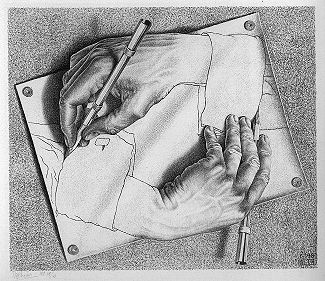 |
Craig White's Literature Courses Correspondence |
 |
Popular use of "correspondence": mail or exchange of papers and ideas; compare input, feedback, dialogue, or texting.
The literary or Romantic use is older but related: a broad state or condition in which one thing exchanges, shares, or agrees with another.
Metaphors: mirroring, reflecting, "they get it from each other," matching,
Quick example: Outside it's a lovely day; inside you feel all sunny and bright. Inside matches outside, or a connetion is felt between interior and exterior connections.
or reverse from outside-in to inside-out:
You wake up feeling bleak and hopeless; when you look out and see a lovely day, you feel like the world is mocking you.
Application to Romantic (and later) literature: Romantic writers used correspondence as a way to describe or represent what we now call cognitive psychology, in this case how the individual mind interacts with its surroundings.
correspondence
according to Oxford English Dictionary:
1.a. The action or fact of corresponding, or answering to each other in fitness or mutual adaptation; congruity, harmony, agreement.
2. a. Relation of agreement, similarity, or analogy.
b. Doctrine of Correspondences n. the tenet of Swedenborg (1688-1772), that every natural object symbolizes or corresponds to some spiritual fact or principle which is, as it were, its archetype or prototype, and that the Scriptures were written in harmony with these correspondences.
6.a. Intercourse or communication by letters.
The "letters" meaning is (or was recently) more common in everyday speech, as in a "correspondence course" where you learn art or other subjects at home while communicating by letter or email with an instructor elsewhere.
But first meaning is important term for an imaginative action or relation.
selected web definitions:
- commensurateness: the relation of corresponding in degree or size or amount
- symmetry: (mathematics) an attribute of a shape or relation; exact reflection of form on opposite sides of a dividing line or plane
- parallelism: similarity by virtue of corresponding
wordnetweb.princeton.edu/perl/webwn
- In theology, correspondence is the relationship between spiritual and
natural realities, or between mental and physical realities. The term was
coined by the 18th century theologian Emanuel Swedenborg in his Arcana
Coelestia (1749-1756) and Heaven and Hell (1758) and other works.
en.wikipedia.org/wiki/Correspondence_(theology)
Romantic concept: relation between inner and outer world, soul and nature, self and cosmos
Emerson, Nature: "every hour and change corresponds to and authorizes a different state of the mind"
"Legend
of Sleepy Hollow": "every
sound of nature, at that witching hour, fluttered [Ichabod's] excited imagination
or reversed: "all the
stories of ghosts and goblins . . . came crowding upon his recollection. The
night grew darker and darker"
reverse: "a mind from which darkness . . . poured forth"
twinning (cf. "William Wilson")
In Poe's Fall of the House of Usher, Roderick and Madeleine are twins with "sympathies of a scarcely intelligible nature"--that is, their "correspondence" is so near that you can't tell one's feelings or ideas from the other's


